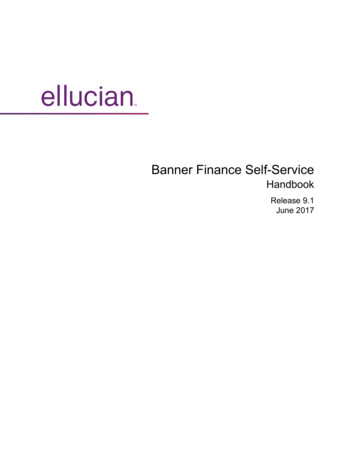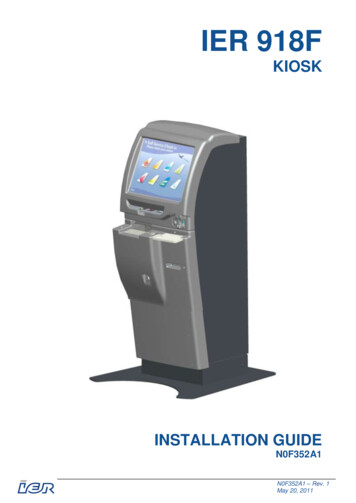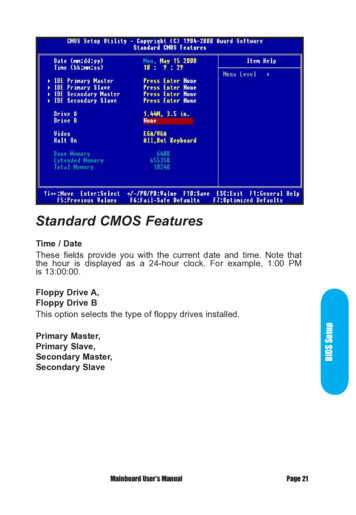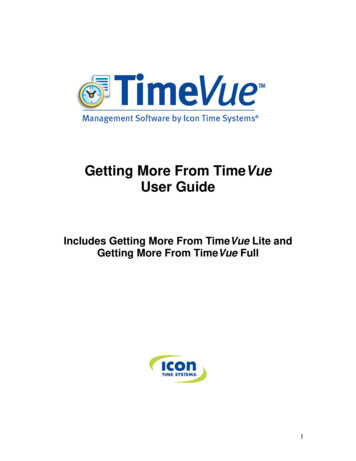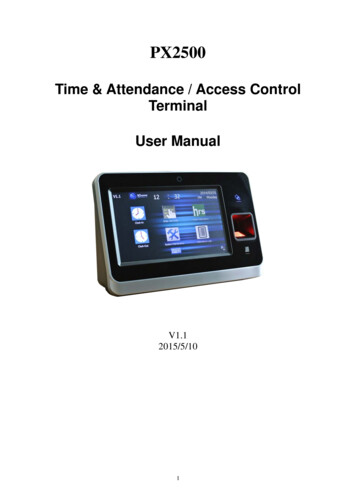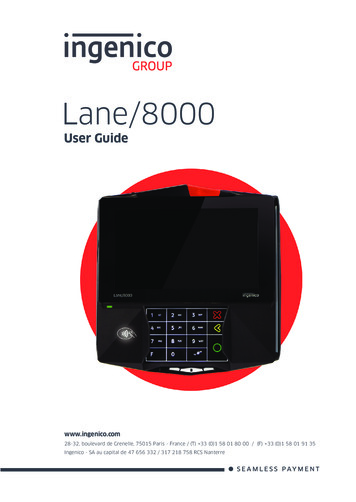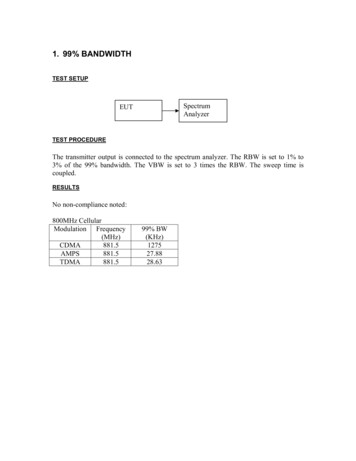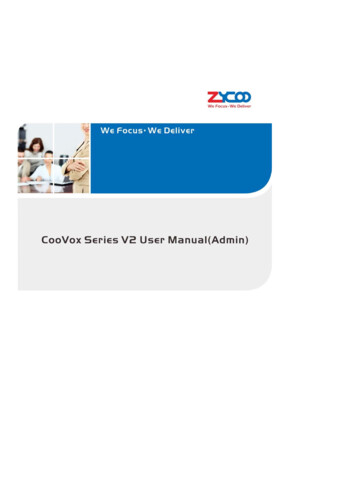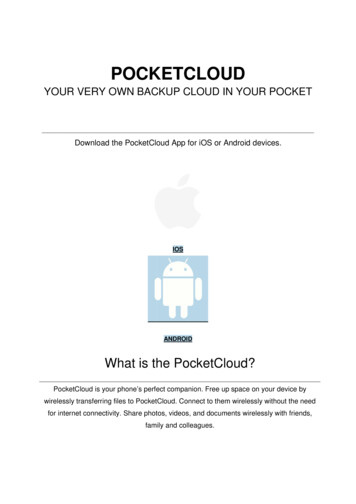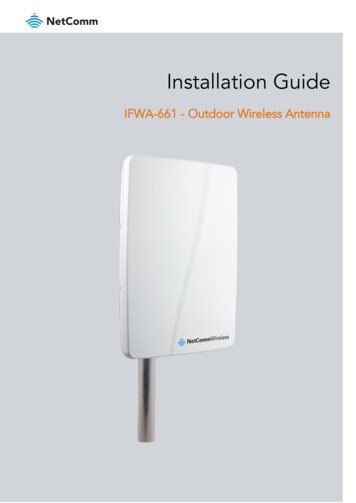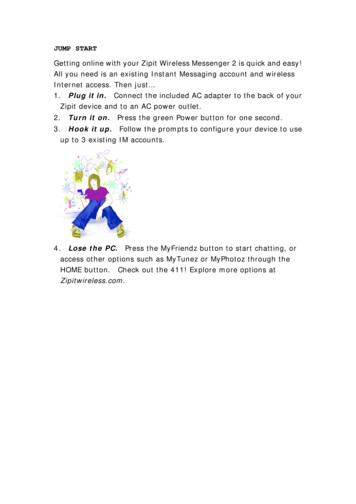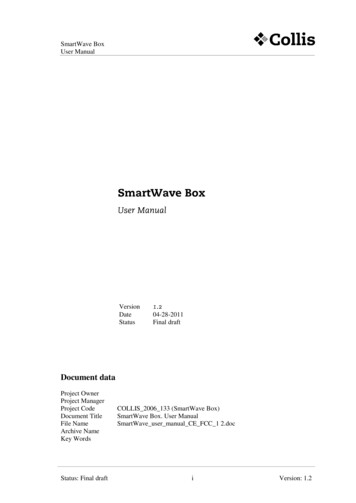
Transcription
SmartWave BoxUser ManualVersionDateStatus04-28-2011Final draftDocument dataProject OwnerProject ManagerProject CodeDocument TitleFile NameArchive NameKey WordsStatus: Final draftCOLLIS 2006 133 (SmartWave Box)SmartWave Box. User ManualSmartWave user manual CE FCC 1 2.dociVersion: 1.2
SmartWave BoxUser ManualTABLE OF CONTENTS1Introduction . 11.11.21.3Scope of document . 1Intended audience . 1Terminology . 12Product Description . 22.1Shipping group . 23System Requirement . 33.13.2Hardware requirements . 3Software requirements . 34Installation. 45Functional Description . 55.15.25.35.45.5Housing . 5LEDs . 5Connectors . 5Terminal / Card side. 6Modes of operation . 65.5.1 Analyzer mode . 75.5.2 Interceptor mode . 75.5.3 Terminal emulation/Card reader mode . 75.5.4 Card simulator mode . 85.5.5 Passive spy mode . 86Communicating with the SmartWave Box . 96.16.2Host interface protocol . 9Tag types . 107Appendix . 127.17.2Technical Information . 12CE/FCC Statement . 148Support . 15References . 16Status: Final draftiiVersion: 1.2
SmartWave BoxUser Manual1INTRODUCTIONThe SmartWave Box, a hardware device, is the perfect solution for testing contactless cards. Itcan read and simulate contactless smart cards; and also can analyze or spy the communicationbetween a contactless card and terminal.With its various modes of operation, the SmartWave Box is the most versatile tool availabletoday for contactless testing.1.1 Scope of documentThis the user manual describes how to setup and use the SmartWave Box.1.2 Intended audienceThis document is intended for the user of the SmartWave Box. Audiences are assumed to havea fair understanding of the standards related to smart cards and CL cards and related tests.1.3 TerminologyTo avoid confusion the term ‘internal terminal’ is used to refer to the internal active antenna ofthe terminal side of the SmartWave Box, the internal terminal communicates with the Cardunder-test (CUT). The external passive antenna is referred as the ‘(CL) probe’ andcommunicates with the Terminal-under-test (TUT).Status: Final draft1/14Version: 1.2
SmartWave BoxUser Manual2PRODUCT DESCRIPTION2.1 Shipping groupSmartWave BoxSmartWave ProbeFirewire cableUSB cableAC/DC power adapterSuckersStatus: Final draftOne (1) unit (Different hardware versions, see 7.1 for details)One (1) unitOne (1) unitOne (1) unitOne (1) unitTwo (2) units2/14Version: 1.2
SmartWave BoxUser Manual3SYSTEM REQUIREMENT3.1 Hardware requirements A free USB port in your PC, support up to USB v2.0.No special requirement for memory size, please check the software application usermanual for corresponding information.3.2 Software requirements Collis test tools may need to be installed in order to use the full functionality of theSmartWave Box.Please contact Collis for software applications information.Status: Final draft3/14Version: 1.2
SmartWave BoxUser Manual4INSTALLATIONPlease use the installation procedure below to setup the SmartWave Box: STEP1Carefully unpack the contents of the shipping group. STEP2Use Fireware cable to connect the SmartWave box with the SmartWave probe. STEP3Connect the SmartWave Box to PC with provided USB cable. STEP4Connect power adapter to the SmartWave Box.Now the box is powered up. The power LED on the box will be turned on. And a beepsound will be generated by the box after initialization. STEP5Install the driver for the SmartWave box by following the driver installation wizard onyour system.Note: The SmartWave Box driver will be installed automatically when installing relatedCollis Test Tools.Then the SmartWave box is ready to use, you may need to install other software from Collis towork together with the SmartWave box. Please check the application user manual for furtherinformation.Status: Final draft4/14Version: 1.2
SmartWave BoxUser Manual5FUNCTIONAL DESCRIPTION5.1 HousingThe SmartWave Box has about the same size as the SmartLink Box. The antenna of the internalterminal is placed underneath the top cover and its position is clearly marked. On the back ofthe SmartWave Box a power connector, a USB connector and the CL probe connector areplaced. On the front of the box are LEDs which shows CL card, terminal status andcommunication. The front also carries test connectors to view information on an oscilloscope.Fig. 1 The SmartWave Box5.2 LEDsThe SmartWave Box has the following LEDs:PowerRed LEDIntern Tx/RxTri-color LED, green Data Rx, red Data TxProbe Tx/RxTri-color LED, green Data Rx, red Data TxInternal terminal RFTri-color LED, green RF only, amber RF and modulationCL probe RFTri-color LED, green RF only, amber RF and modulationThe communication signaling of the tri-color LEDs is stretched, i.e. short frames are show asbeing longer.5.3 ConnectorsThe SmartWave Box is fitted with the following coaxial connectors for connection with anoscilloscope:Internal terminal RFInternal raw data (Rx)Internal Tx dataExternal terminal RFExternal raw data (Rx)Status: Final draftBuffered antenna RF signal of the internal terminalRaw Rx dataTransmit dataBuffered antenna RF signal of the internal terminalRaw Rx data5/14Version: 1.2
SmartWave BoxUser ManualExternal Tx dataTrigger outputTransmit dataPositive pulse, 1 μs, on selected triggerFor hardware version 2.21 the following connectors are placed at the back panel:Trigger inputPositive pulseTrigger outputPositive pulse, 1 μs, on selected triggerAnalog output levels, like RF and demodulated RF, are 0 – 3.3 Volt.Digital outputs inverting buffer ports, 0 – 3.3 Volt.Fig. 2 Front panel of the SmartWave boxThe test connectors are MCX female PCB-mounted connectors.Note: Check section 7.1 Technical for other detail technical data.5.4 Terminal / Card sideThe SmartWave Box has an internal terminal for terminal emulation and a CL probe to emulateas a CL card for communication with the CL terminal.Both the internal terminal and the CL probe support ISO 14443 Type A and B and ISO 18092NFCIP-1.The CL probe is connected by a cable with the SmartWave Box, using a 6 pin FireWireconnector at the backpanel of the box.All communications with CUT and / or TUT are performed with nominal values for magneticfield strength and modulation depths, since reliable tests with other values require a, per test,calibration of these values. Tests of ISO 14443/2 will not be performed with the SmartWaveBox, although the SmartWave Box facilitates these measurements with the analog RF outputconnectors.5.5 Modes of operationThe SmartWave Box has the following modes of operation: Analyzer mode Interceptor mode Terminal emulation/Card reader mode Card simulator mode Passive spy modeStatus: Final draft6/14Version: 1.2
SmartWave BoxUser Manual5.5.1Analyzer modeThe CL CUT and the TUT are connected via the SmartWave Box. The SmartWave Box willresupply the RF signal driver. In addition I/O direction information, CL card power level (ifsupplied by the card) and timestamps are transferred to the driver.The I/O and I/O direction information is output to high impedance connectors on the front ofthe SmartWave Box (Different output can be configured through API).Power levels if available are relative otherwise it requires calibration for each test and test setupwith a known (external) reference.5.5.2Interceptor modeThe interceptor mode looks the same as the Analyzer mode; however the I/O data is notdirectly moved between the CUT and the TUT. The data from CL card or the terminal is sent tothe host computer which will send the same or modified data to the terminal or the CL card.Due to timing constraints the level 3 anti-collision is performed directly by card and terminalwithout host intervention, however all frames are passed to the host. After that the level 4transfers are routed via the host computer.5.5.3Terminal emulation/Card reader modeIn the terminal emulation mode the SmartWave Box acts as an intelligent CL card reader. Thisenables tests with various bit rates and modulation types.This mode can be used to perform the tests as described in ISO 10373-6 Amd.1 and ISO 23917,apart of the level 2 tests.Status: Final draft7/14Version: 1.2
SmartWave BoxUser Manual5.5.4Card simulator modeIn the card simulator mode only the CL probe is used and directly controlled by the hostcomputer.This mode can be used to perform the tests as described in ISO 10373-6 Amd.3 and ISO 23917,apart from level 2 tests.5.5.5Passive spy modeThe card spying mode uses a passive pick-up coil to capture communication between a CL cardand a terminal. Neither the CL card nor the terminal needs to be connected with the hostcomputer. Care is taken to influence the CL card – terminal communication a less as possible. Note: The passive spy mode is only available with v02.00 hardware; active spy will be usedon v01.xx boxes.With active spy, it works using the setup like analyse mode, while the box only forwards theraw signal between CUT and TUT instead of transmitting bytes.Status: Final draft8/14Version: 1.2
SmartWave BoxUser Manual6COMMUNICATING WITH THE SMARTWAVE BOXThe SmartWave Box is command driven. The host computer configures the SmartWave Boxand will either passively capture data or actively interact with CL card or terminal.The frame transfer is of a request – response type, where the host computer sends the requestsand the SmartWave Box sends the response.For some events the SmartWave Box sends unsolicited messages.6.1 Host interface protocolThe host computer – SmartWave Box protocol is TLV (Tag, Length, Value) based, this allowseasy adaptations in the future.Every message, both from the host or from the SmartWave Box, starts with a 2 byte start framedelimiter (SFD) and ends with an end frame delimiter (EFD). The 1st byte of the SFD 0xF3,the 2nd byte 0xA0, the 1st byte of the EFD 0x0E, the 2nd byte 0xFD.A command message can contain a number of TLV structures, the responses also contain morethan one TLV, see below.SFDTag0 Len0 Value0 Tag1 Len1 Value1TagNLenN ValueNEFDTo ease processing by 16-bit word based processors, all fields have an even length. The basicstructure of a TLV field is shown below:LengthNameDescription2TagThe Tag signals value type2LengthThis field shows the length of the following value (always even)0 - 65534 ValueThe field contains the relevant data.NB.If the length field equals 00 00, the value field is not available.When the data in the value field has an odd length, that length has to given in the Len field andValue field is padded with a zero byte, resulting in an even Value field length. So when 7 bytesof data (11 22 33 44 55 66 77) have to be transferred, the message will be as follows:SFDF3 A0Tag00 xxLength00 07Value11 22 33 44 55 66 77Padding00EFD0E FDWhen the length of the value field exceeds 65534, the value field is split in 2 parts; the 1st partwith a length of 65534 and a 2nd part containing the rest with an ‘extended data’ tag.For example a frame with a length of 6600 0 bytes (0x101D0) to be sent to the TUT will betransferred as follow (al hex values):SFDF3 A0Tag00 21Length ValueTag ext.FF FE Data (part 1) 00 80Status: Final draft9/14Length Value01 D2 Data (rest)EFD0E FDVersion: 1.2
SmartWave BoxUser Manual6.2 Tag typesThe following Tag fields are defined:NameBox control commandBox info commandBox control responseBox info responseBox eventBox trigger timestampTerminal transmit TPDUProbe transmit TPDUConnectError controlReceived antenna TPDUReceived probe TPDUConnection statusTimestampStatusTerminal download dataProbe download dataTerminal register dumpProbe register dumpWrite PLL dataWrite DAC dataDownload data statusExtended dataValue(hex)00 0000 0100 1000 1100 1500 1600 2000 2100 2300 2500 3000 3100 3300 3500 3600 4000 4100 4200 4300 4800 4900 5000 80DescriptionCommands to the SmartWave BoxGet SmartWave Box informationResponse of Box control commandResponse of Box info commandUnsolicited event from boxUnsolicited timestamp event of trigger momentTPDU data to internal terminal (to be sent to CUT)TPDU data to CL probe (to be sent to TUT)Start connection with CUT and / or TUTError injection controlTPDU data from internal terminal (received from CUT)TPDU data received from CL probe (received from TUT)Status of connection commandTimestamps connected to received dataStatus of received dataData loaded for terminal emulationData loaded for card emulationTerminal RF chip register dump (debug only)Probe RF chip register dump (debug only)Write data to PLL (debug only)Write data to DAC (debug only)Status of data loaded for terminal or card emulationLast part of data field with more than 65534 bytes(This tag must directly follow the 1st data part)Source and destination addressing is implicit and depends on the tag value. Tags destined forthe SmartWave Box have an even high nibble for the low byte, responses have odd high nibblesof the low bytes (apart from tag 00 80).Some messages from the host only allow for one type of tag, other messages allow a number ofspecified tags.Single tag type messages only can have a single tag 00 00, 00 01, 00 23, 00 40 and 00 41(hex).Multiple tag messages can have the following combinations:- tag 00 20 followed by 00 80 and / or 00 25 (hex)- tag 00 21 followed by 00 80 and / or 00 25 (hex)Tag 00 25 can’t be the first tag in a message.Messages from the SmartWave Box with tags of 00 10, 00 11, 00 15, 00 16, 00 33 and 00 50(hex) are single tag messages, tag 00 01 only may occur once in a message.Tags 00 10 and 00 11 are response messages for respectively 00 00 and 00 01.Tag 00 33 is the response of tag 00 23.Status: Final draft10/14Version: 1.2
SmartWave BoxUser ManualTag 00 50 is the response status for either 00 40 or 00 41 command tags.Messages starting with 00 30 or 00 31 (hex) are multiple tag messages and can be followed bytags 00 80, 00 35 and / or 00 36 (hex).The SmartWave Box only reacts on messages starting with tag values 00 00, 00 01, 00 20, 0021, 00 23, 00 40or 00 41, other tag values are quietly discarded.The data transfers between host and SmartWave Box are Transport Protocol Data Unit (TPDU)based. That allows the transfer of level 3 and 4 frames. For level 4 also Application ProtocolData Units (APDUs) are defined. APDUs to the SmartWave Box must translated by the hostinto TPDUs and back.Note: Checksums, like LRC and CRC, have to be supplied by the host computer. Thechecksum coming from the SmartWave Box have to be checked by the host computer.In case of higher level tests the SmartWave Box can connect automatically with the card orterminal under test if commanded to. That allows level 4 testing without need for level 3handling.Note: Check the technical specification of the SmartWave Box for detail host protocolinformation.Status: Final draft11/14Version: 1.2
SmartWave BoxUser Manual7APPENDIX7.1 Technical InformationPower consumptionPower adapterWorking frequencyUSBmax 5.5W18V/840mA13.56Mhz2.0Physical dimensions (LxWx(H1-H2))Temperature166.5x126x(34-43) 55 C (max)(equipment for normal indoor use)WeightSound373gTransducerProbe dimension: (LxWxH)Probe weight:189x58x1239gAnalog output levels (e.g. -INTERN- ANT): 0 – 3.3 Volt (max).Digital outputs level(s): 0 – 3.3 Volt.Digital inputs level(s): 0 – 3.3/5 Volt.Hardware version 2.10 supports the following modes:ISO 14443 Type AISO 14443 Type BNFCIP-1Status: Final draftSpying modeAnalyze modeIntercept modeContactless Card SimulatorTerminal Emulation/Card reader modeSpying modeAnalyze modeIntercept modeContactless Card SimulatorTerminal Emulation/Card reader modeSpying modeAnalyze modeIntercept modeContactless Card SimulatorTerminal Emulation/Card reader mode12/14Version: 1.2
SmartWave BoxUser ManualHardware version 2.21 supports the following modes:ISO 14443 Type AISO 14443 Type BNFCIP-1Status: Final draftSpying modeAnalyze modeIntercept modeContactless Card SimulatorTerminal Emulation/Card reader modeSpying modeAnalyze modeIntercept modeContactless Card SimulatorTerminal Emulation/Card reader modeSpying modeAnalyze modeIntercept modeContactless Card SimulatorTerminal Emulation/Card reader mode13/14Version: 1.2
SmartWave BoxUser Manual7.2 CE/FCC StatementCEThis equipment has been tested and found to comply with the limits of the European CouncilDirective on the approximation of the member states relating to electromagnetic compatibility.(98/336/EEC) according to EN 55022 Class B.FCCWarning (part 15.21)Changes or modifications not expressly approved by the party responsible for compliancecould void the user’s authority to operate the equipment.RF Exposure (OET Bulletin 65)To comply with FCC RF exposure requirements for mobile transmitting devices, thistransmitter should only be used or installed at locations where there is at least 20cmseparation distance between the antenna and all persons.This equipment has been tested and found to comply with the limits for a Class B digitaldevice, pursuant to Part 15 of the FCC Rules. These limits are designed to provide reasonableprotection against harmful interference in a residential energy and, if not installed and used inaccordance with the instructions, may cause harmful interference to radio communications.However, there is no guarantee that interference will not occur in a particular installation.Compliance statement FCC and Industry CanadaThis device complies with part 15 of the FCC Rules and to RSS210 of Industry Canada.Operation is subject to the following two conditions:(1) this device may not cause harmful interference, and(2) this device must accept any interference received, including interference that maycause undesired operation.Le présent appareil est conforme aux CNR d'Industrie Canada applicables aux appareils radioexempts de licence. L'exploitation est autorisée aux deux conditions suivantes : (1) l'appareil nedoit pas produire de brouillage, et (2) l'utilisateur de l'appareil doit accepter tout brouillageradioélectrique subi, même si le brouillage est susceptible d'en compromettre lefonctionnement.Status: Final draft14/14Version: 1.2
SmartWave BoxUser Manual8SUPPORTFor troubleshooting, support or more information contact Collis BVE-mailTelephone: service@collis.nl: 31 71 581 3636Status: Final draft15/14Version: 1.2
SmartWave BoxUser ][11][12][13]TitleISO 7816/3Smart Card standard,electrical signals and transmission protocolsISO 7816/4Smart Card standard,interindustry commands for interchangeISO 14443/2 CL card standard – proximity cards,RF interface power and signal interface( Amendment 1)ISO 14443/3 CL card standard – proximity cards,initialization and anticollision.( Amendments 1 and 3)ISO 14443/4 CL card standard – proximity cards,transmission protocol( Amendment 1)ISO 18092Near Field Communication cards,interface and protocolISO 10273-6 Identification cards, test methodsproximity cardsISO 10273-6 Amendment 1Protocol test methods for proximity cardsISO 10273-6 Amendment 3Protocol test methods for proximity coupling devicesISO 10273-6 Amendment 5Bit rates of fc/64, fc/32 and fc/16ISO 23917NFCIP-1 protocol test methodsSmartWave Box requirement specification documentSmartWave Box Technical SpecificationStatus: Final aldraftFinaldraftFinaldraftFinalVersion: 1.2
Project Code COLLIS_2006_133 (SmartWave Box) Document Title SmartWave Box. User Manual File Name SmartWave_user_manual_CE_FCC_1 2.doc Archive Name Key Words . Collis test tools may need to be installed in order to use the full functionality of the SmartWave Box.
